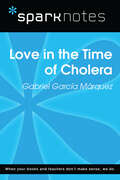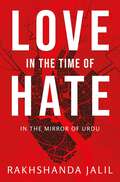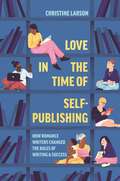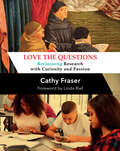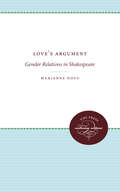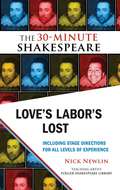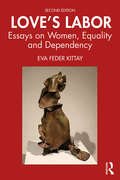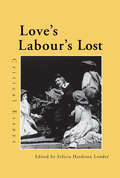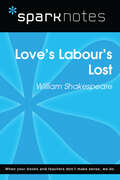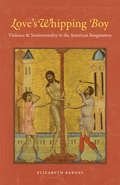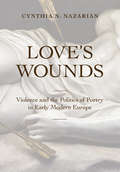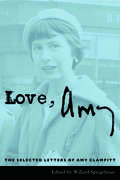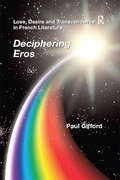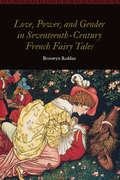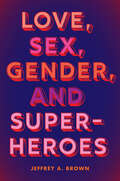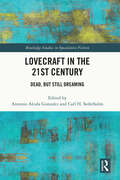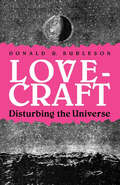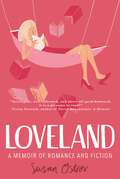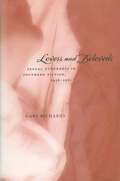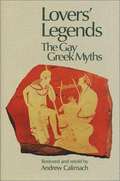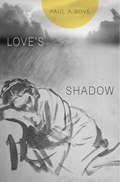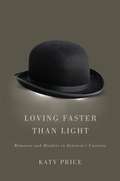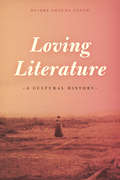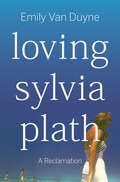- Table View
- List View
Love in the Time of Cholera (SparkNotes Literature Guide Series)
by SparkNotesLove in the Time of Cholera (SparkNotes Literature Guide) by Gabriel Garcia Marquez Making the reading experience fun! Created by Harvard students for students everywhere, SparkNotes is a new breed of study guide: smarter, better, faster. Geared to what today's students need to know, SparkNotes provides: *Chapter-by-chapter analysis *Explanations of key themes, motifs, and symbols *A review quiz and essay topicsLively and accessible, these guides are perfect for late-night studying and writing papers
Love in the Time of Hate: In the Mirror of Urdu
by Dr Rakhshanda JalilKabhi hum bhi tum bhi thhe aashna tumhein yaad ho ke na yaad ho Once you and I were friends, whether you remember it now or not--Momin Khan Momin This is a book about love—love for one&’s country and for all that goes to make it one we can be proud to belong to. Poetry, it has been said, flourishes when all else is uncertain. With that in mind, renowned literary historian and translator, Rakhshanda Jalil, uses Urdu poetry to look at how the social fabric of secular India is changing. Rakhshanda delves into the past, to the events that have threatened communal harmony, from the bloodletting of partition, or the politics of successive elections, to communal riots, Mumbai, Gujarat and so on, to the present moment, to recent events around Ayodhya, cow slaughter and &‘love jihad&’. The book is divided into four sections: politics, people, passions, places. Strewn with delightful, thoughtful Urdu couplets that bring depth, lyricism and gravitas to the narratives, the writer cautions us against current popular sentiments based on hating the &‘other&’. Living in an India that now requires us to be resolutely one or the &‘other&’, all of us are losing the wonderful capacity to contain within ourselves many seemingly diverse ideologies and beliefs which is a motif that is reiterated through the verses and words in this book. The section titled &‘People&’ has the most delightful, charming vignettes of popular icons, from Tipu Sultan and Rani Lakshmi Bai to Gandhi and Nehru, from Ghalib and Majaz to Dilip Kumar and Lata Mangeshkar, viewed through an Urdu lens that makes each person memorable, unique and an advocate of peace and unity. From essays doused in the language of secular patriotism like Har Dil Tiranga, to pieces redolent with nostalgia like Dopahar ki Dhoop Mein, Rakhshanda invokes the power of love, inclusivity and communal harmony that is the trademark of poetry and literature, and which must continue to permeate the way we live our lives if we want to bequeath a meaningful legacy to the generations to come in our country.
Love in the Time of Self-Publishing: How Romance Writers Changed the Rules of Writing and Success
by Christine M. LarsonLessons in creative labor, solidarity, and inclusion under precarious economic conditionsAs writers, musicians, online content creators, and other independent workers fight for better labor terms, romance authors offer a powerful example—and a cautionary tale—about self-organization and mutual aid in the digital economy. In Love in the Time of Self-Publishing, Christine Larson traces the forty-year history of Romancelandia, a sprawling network of romance authors, readers, editors, and others, who formed a unique community based on openness and collective support. Empowered by solidarity, American romance writers—once disparaged literary outcasts—became digital publishing&’s most innovative and successful authors. Meanwhile, a new surge of social media activism called attention to Romancelandia&’s historic exclusion of romance authors of color and LGBTQ+ writers, forcing a long-overdue cultural reckoning.Drawing on the largest-known survey of any literary genre as well as interviews and archival research, Larson shows how romance writers became the only authors in America to make money from the rise of ebooks—increasing their median income by 73 percent while other authors&’ plunged by 40 percent. The success of romance writers, Larson argues, demonstrates the power of alternative forms of organizing influenced by gendered working patterns. It also shows how networks of relationships can amplify—or mute—certain voices.Romancelandia&’s experience, Larson says, offers crucial lessons about solidarity for creators and other isolated workers in an increasingly risky employment world. Romancelandia&’s rise and near-meltdown shows that gaining fair treatment from platforms depends on creator solidarity—but creator solidarity, in turn, depends on fair treatment of all members.
Love the Questions: Reclaiming Research with Curiosity and Passion
by Catherine FraserWith boundless amounts of information available, it is vital that students become skilled at the art of research. In Love the Questions: Reclaiming Research with Curiosity and Passion , author Cathy Fraser outlines ways students can engage with their research projects and truly internalize and transform content.Inside you&’ll learn how to do the following: Honor students&’ passions, interests, and questions by teaching how to embrace inquiry, curiosity, and exploration Teach students how to frame relevant questions throughout the research process and make the information personal Develop authentic projects that include surveys, experiments, and interviews Assess skills, not just memorization by recognizing and legitimizing what students are doing with research on their own Fraser also includes mini lessons, practice activities, graphic organizers, and student examples within the book. Love the Questions recommends teachers and students work with librarians and other school leaders as educational partners, helping students continue to develop their analytical and logical skills.
Love's Argument: Gender Relations in Shakespeare
by Marianne NovyNovy demonstrates how the plays are theatrical transformations of tensions in both ideals and practices in Renaissance society. Analyzing the dramatic images of lover and beloved, of husband and wife, of parent and child, Novy examines the ways in which the conflicts are resolved in the comedies and romances and how they are acted out in the tragedies. Chapters on individual plays provide original interpretations that delineate the tone and texture of gender relations.A UNC Press Enduring Edition -- UNC Press Enduring Editions use the latest in digital technology to make available again books from our distinguished backlist that were previously out of print. These editions are published unaltered from the original, and are presented in affordable paperback formats, bringing readers both historical and cultural value.
Love's Enlightenment: Rethinking Charity in Modernity
by Ryan Patrick HanleyA number of prominent moral philosophers and political theorists have recently called for a recovery of love. But what do we mean when we speak of love today? Love's Enlightenment examines four key conceptions of other-directedness that transformed the meaning of love and helped to shape the way we understand love today: Hume's theory of humanity, Rousseau's theory of pity, Smith's theory of sympathy, and Kant's theory of love. It argues that these four Enlightenment theories are united by a shared effort to develop a moral psychology that can provide both justificatory and motivational grounds for concern for others in the absence of recourse to theological or transcendental categories. In this sense, each theory represents an effort to redefine the love of others that used to be known as caritas or agape - a redefinition that came with benefits and costs that have yet to be fully appreciated.
Love's Labor's Lost: The 30-Minute Shakespeare
by Nick NewlinLove's Labor's Lost: The 30-Minute Shakespeare plays three action-packed scenes from this tale of King Navarre and his three lords, who have vowed to retire from women for three years. Naturally, the Princess of France and her three ladies arrive, and comedic courtship ensues.The cutting includes the ridiculous dance of the lords disguised as Russians, the hysterical "Pageant of the Nine Worthies," and a dramatic, bittersweet ending that leaves the King and the three lords laboring for love.The edition includes a preface by Nick Newlin containing helpful advice on how to put on a Shakespeare performance in a high school class with novice actors, as well as an appendix with suggestions for the specific play and recommendations for further resources.
Love's Labor: Essays on Women, Equality and Dependency
by Eva Feder KittayThis new edition of Eva Feder Kittay’s feminist classic, Love’s Labor, explores how theories of justice and morality must be reconfigured when intersecting with care and dependency, and the failure of policy towards women who engage in care work. The work is hailed as a major contribution to the development of an ethics of care. Where society is viewed as an association of equal and autonomous persons, the work of caring for dependents figures neither in political theory nor in social policy. While some women have made many gains, equality continues to elude many others, as in large measure, social institutions fail to take into account the dependency of childhood, illness, disability and frail old age and fail to adequately support those who care for dependents. Using a narrative of her experiences caring for her disabled daughter, Eva Feder Kittay discusses the relevance of her analysis of dependency to significant cognitive disability. She explores the significance of dependency work by analyzing John Rawls' influential liberal theory and two examples of public policy—welfare reform and family leave—to show how theory and policy fail women when they miss the centrality of dependency to issues of justice. This second edition has updated material on care workers, her adult disabled daughter and key changes in welfare reform. Using a mix of personal reflection and political argument, this new edition of a classic text will continue to be an innovative and influential contribution to the debate on searching for greater equality and justice for women. Love’s Labor has spoken to audiences around the world and has had an impact on readers from many countries and in many disciplines: philosophy, sociology, disability studies, nursing. It has been required and supplementary reading on many undergraduate courses on Ethics, Feminist Ethics, Gender and Religious Ethics, Political Theory, Bioethics and Disability Studies. It has been translated into Italian, Japanese and Korean.
Love's Labour's Lost: Critical Essays (Shakespeare Criticism)
by Felicia Hardison LondreThis anthology examines Love's Labours Lost from a variety of perspectives and through a wide range of materials. Selections discuss the play in terms of historical context, dating, and sources; character analysis; comic elements and verbal conceits; evidence of authorship; performance analysis; and feminist interpretations. Alongside theater reviews, production photographs, and critical commentary, the volume also includes essays written by practicing theater artists who have worked on the play. An index by name, literary work, and concept rounds out this valuable resource.
Love's Labours Lost (SparkNotes Literature Guide Series)
by SparkNotesLove's Labours Lost (SparkNotes Literature Guide) by William Shakespeare Making the reading experience fun! Created by Harvard students for students everywhere, SparkNotes is a new breed of study guide: smarter, better, faster. Geared to what today's students need to know, SparkNotes provides: *Chapter-by-chapter analysis *Explanations of key themes, motifs, and symbols *A review quiz and essay topicsLively and accessible, these guides are perfect for late-night studying and writing papers
Love's Whipping Boy: Violence and Sentimentality in the American Imagination
by Elizabeth BarnesWorking to reconcile the Christian dictum to "love one's neighbor as oneself" with evidence of U. S. sociopolitical aggression, including slavery, corporal punishment of children, and Indian removal, Elizabeth Barnes focuses her attention on aggressors--rather than the weak or abused--to suggest ways of understanding paradoxical relationships between empathy, violence, and religion that took hold so strongly in nineteenth-century American culture. Looking at works by Herman Melville, Frederick Douglass, Nathaniel Hawthorne, and Louisa May Alcott, among others, Barnes shows how violence and sensibility work together to produce a more "sensitive" citizenry. Aggression becomes a site of redemptive possibility because salvation is gained when the powerful protagonist identifies with the person he harms. Barnes argues that this identification and emotional transformation come at a high price, however, as the reparative ends are bought with another's blood. Critics of nineteenth-century literature have tended to think about sentimentality and violence as opposing strategies in the work of nation-building and in the formation of U. S. national identity. Yet to understand how violence gets folded into sentimentality's egalitarian goals is to recognize, importantly, the deep entrenchment of aggression in the empathetic structures of liberal, Christian culture in the United States.
Love's Wounds: Violence and the Politics of Poetry in Early Modern Europe
by Cynthia N. NazarianLove's Wounds takes an in-depth look at the widespread language of violence and abjection in early modern European love poetry. Beginning in fourteenth-century Italy, this book shows how Petrarch established a pattern of inequality between suffering poet and exalted Beloved rooted in political parrhēsia. Sixteenth- and early seventeenth-century French and English poets reshaped his model into an idiom of extravagant brutality coded to their own historical circumstances. Cynthia N. Nazarian argues that these poets exaggerated the posture of the downtrodden lover, adapting the rhetoric of powerless desire to forge a new "countersovereignty" from within the heart of vulnerability—a potentially revolutionary position through which to challenge cultural, religious, and political authority. Creating a secular equivalent to the martyr, early modern sonneteers crafted a voice that was both critical and unstoppable because it suffered.Love’s Wounds tracks the development of the countersovereign voice from Francesco Petrarca to Maurice Scève, Joachim du Bellay, Théodore-Agrippa d’Aubigné, Edmund Spenser, and William Shakespeare. Through interdisciplinary and transnational analyses, Nazarian reads early modern sonnets as sites of contestation and collaboration and rewrites the relationship between early modern literary forms.
Love, Amy: The Selected Letters of Amy Clampitt
by Amy ClampittThis extraordinary collection of letters sheds light on one of the most important postwar American poets and on a creative woman's life from the 1950s onward. Amy Clampitt was an American original, a literary woman from a Quaker family in rural Iowa who came to New York after college and lived in Manhattan for almost forty years before she found success (or before it found her) at the age of 63 with the publication of The Kingfisher. Her letters from 1950 until her death in 1994 are a testimony to her fiercely independent spirit and her quest for various kinds of truth-religious, spiritual, political, and artistic.Written in clear, limpid prose, Clampitt's letters illuminate the habits of imagination she would later use to such effect in her poetry. She offers, with wit and intelligence, an intimate and personal portrait of life as an independent woman recently arrived in New York City. She recounts her struggle to find a place for herself in the world of literature as well as the excitement of living in Manhattan. In other letters she describes a religious conversion (and then a gradual religious disillusionment) and her work as a political activist. Clampitt also reveals her passionate interest in and fascination with the world around her. She conveys her delight in a variety of day-to-day experiences and sights, reporting on trips to Europe, the books she has read, and her walks in nature. After struggling as a novelist, Clampitt turned to poetry in her fifties and was eventually published in the New Yorker. In the last decade of her life she appeared like a meteor on the national literary scene, lionized and honored. In letters to Helen Vendler, Mary Jo Salter, and others, she discusses her poetry as well as her surprise at her newfound success and the long overdue satisfaction she obviously felt, along with gratitude, for her recognition.
Love, Desire and Transcendence in French Literature: Deciphering Eros
by Paul GiffordEuropean literature and theory of the twentieth century have been intensely preoccupied with questions of 'Desire', whereas 'love' has increasingly represented a fractured and strange, if not actually suspect, proposal: this is a prime symptom of an age of deep cultural mutation and uncertainty. Paul Gifford's book allows this considerable contemporary phenomenon to be observed steadily and whole, with strategic understanding of its origins, nature and meaning. Gifford paints a clear and coherent picture of the evolution of erotic ideas and their imaginary and formal expressions in modern French writing. He first retraces the formative matrix of French tradition by engaging with five classic sources: Plato's Symposium, the Song of Songs, the myth of Genesis, the tension between Greek Eros and Christian Agape and the repercussions of Nietzsche's declaration of the 'death of God'. Modern variations on these perennial problematics are then pursued in ten chapters devoted to Proust, Valéry, Claudel, Breton, Bataille, Duras, Barthes, Irigarary, Emmanuel, Kristeva. Literary and theoretical perspectives are perfectly blended in his study of these attempts at 'deciphering Eros'. The book will appeal not only to students of French literature, but to all those interested in the cultural upheavals of the twentieth century.
Love, Power, and Gender in Seventeenth-Century French Fairy Tales (Women and Gender in the Early Modern World)
by Bronwyn ReddanLove is a key ingredient in the stereotypical fairy-tale ending in which everyone lives happily ever after. This romantic formula continues to influence contemporary ideas about love and marriage, but it ignores the history of love as an emotion that shapes and is shaped by hierarchies of power including gender, class, education, and social status. This interdisciplinary study questions the idealization of love as the ultimate happy ending by showing how the conteuses, the women writers who dominated the first French fairy-tale vogue in the 1690s, used the fairy-tale genre to critique the power dynamics of courtship and marriage. Their tales do not sit comfortably in the fairy-tale canon as they explore the good, the bad, and the ugly effects of love and marriage on the lives of their heroines. Bronwyn Reddan argues that the conteuses&’ scripts for love emphasize the importance of gender in determining the &“right&” way to love in seventeenth-century France. Their version of fairy-tale love is historical and contingent rather than universal and timeless. This conversation about love compels revision of the happily-ever-after narrative and offers incisive commentary on the gendered scripts for the performance of love in courtship and marriage in seventeenth-century France.
Love, Sex, Gender, and Superheroes: Photogenic French Literature And The Prehistory Of Cinematic Modernity
by Jeffrey A. BrownImpossibly muscular men and voluptuous women parade around in revealing, skintight outfits, and their romantic and sexual entanglements are a key part of the ongoing drama. Such is the state of superhero comics and movies, a genre that has become one of our leading mythologies, conveying influential messages about gender, sexuality, and relationships. Love, Sex, Gender, and Superheroes examines a full range of superhero media, from comics to films to television to merchandising. With a keen eye for the genre’s complex and internally contradictory mythology, comics scholar Jeffrey A. Brown considers its mixed messages. Superhero comics may reinforce sex roles with their litany of phallic musclemen and slinky femme fatales, but they also blur gender binaries with their emphasis on transformation and body swaps. Similarly, while most heroes have heterosexual love interests, the genre prioritizes homosocial bonding, and it both celebrates and condemns gendered and sexualized violence. With examples spanning from the Golden Ages of DC and Marvel comics up to recent works like the TV series The Boys, this study provides a comprehensive look at how superhero media shapes our perceptions of love, sex, and gender.
Lovecraft in the 21st Century: Dead, But Still Dreaming (Routledge Studies in Speculative Fiction)
by Carl H. Sederholm Antonio Alcala GonzalezLovecraft in the 21st Century assembles reflections from a wide range of perspectives on the significance of Lovecraft’s influence in contemporary times. Building on a focus centered on the anthropocene, adaptation, and visual media, the chapters in this collection focus on the following lines: Adaptation of Lovecraft’s legacy in theater, television, film, graphic narratives, and game artwork The connection between the writer’s legacy and his life Considering capitalism, the posthuman, and the Anthropocene when reading Lovecraft How contemporary authors have worked through the implicit racial and sexual politics in Lovecraft’s fiction. Reading Lovecraft’s fiction in light of contemporary approaches to gender and sexuality
Lovecraft: Disturbing the Universe
by Donald R. BurlesonHoward Phillips Lovecraft (1890–1937) has been described variously as the successor to Edgar Allan Poe, a master of the Gothic horror tale, and one of the father of modern supernatural fantasy fiction. Published originally in pulp magazines, his works hav
Loveland: A Memoir of Romance and Fiction
by Susan OstrovThis is not your usual memoir – much less a typical love story.Loveland is about the unfolding of unmet expectations, of shattered childhood dreams, of tenderness found unexpectedly; it is the uncovering of different layers of one' s self, relationship after relationship.The rationale for understanding the engineering of love, in its infinite nuances, comes through the framework of literature. Books shape our perceptions: their characters set parameters, their stories create paradigms, and we live by them forever.If you' re interested in a different vision of happily-ever-after, this is the book for you.
Lovers and Beloveds: Sexual Otherness in Southern Fiction, 1936--1961 (Southern Literary Studies)
by Gary RichardsA challenge to traditional criticism, this engaging study demonstrates that issues of sexuality-and same-sex desire in particular-were of central importance in the literary production of the Southern Renaissance. Especially during the end of that period-approximately the 1940s and 1950s-the national literary establishment tacitly designated the South as an allowable setting for fictionalized deviancy, thus permitting southern writers tremendous freedom to explore sexual otherness. In Lovers and Beloveds, Gary Richards draws on contemporary theories of sexuality in reading the fiction of six writers of the era who accepted that potentially pejorative characterization as an opportunity: Truman Capote, William Goyen, Harper Lee, Carson McCullers, Lillian Smith, and Richard Wright. Richards skillfully juxtaposes forgotten texts by those writers with canonical works to identify the complex narratives of same-sex desire. In their novels and stories, the authors consistently reimagine gender roles, centralize homoeroticism, and probe its relationship with class, race, biological sex, and southern identity. This is the first book to assess the significance of same-sex desire in a broad range of southern texts, making a crucial contribution to the study of both literature and sexuality.
Lovers' Legends: The Gay Greek Myths
by Andrew CalimachFirst comprehensive uncensored collection of homosexual Greek myths in years. Lucians Different Loves, an unabashed debate on gay vs. straight love, frames richly illustrated stories of Hercules, Orpheus, Narcissus, others. Presents positive and negative aspects of Greek male love within historical/cultural context. Carefully documented, suitable for classes in gender studies / history / religion. Notes, bibliography, glossary, map. Study guide forthcoming.
Love’s Shadow
by Paul A. BovéA case for literary critics and other humanists to stop wallowing in their aestheticized helplessness and instead turn to poetry, comedy, and love.Literary criticism is an agent of despair, and its poster child is Walter Benjamin. Critics have spent decades stewing in his melancholy. What if instead we dared to love poetry? To choose comedy over Hamlet’s tragedy, romance over Benjamin’s suicide on the edge of France, of Europe, of civilization?Paul Bové challenges young lit critters to throw away their shades and let the sun shine in. Love’s Shadow is his three-step manifesto for a new literary criticism that risks sentimentality and melodrama and eschews self-consciousness. The first step is to choose poetry. There has been since the time of Plato a battle between philosophy and poetry. Philosophy has championed misogyny, while poetry has championed women, like Shakespeare’s Rosalind. Philosophy is ever so stringent; try instead the sober cheerfulness of Wallace Stevens. Bové’s second step is to choose the essay. He praises Benjamin’s great friend and sometime antagonist Theodor Adorno, who gloried in the writing of essays, not dissertations and treatises. The third step is to choose love. If you want a Baroque hero, make it Rembrandt, who brought lovers to life in his paintings.Putting aside passivity and cynicism would amount to a revolution in literary studies. Bové seeks nothing less, and he has a program for achieving it.
Loving Faster than Light: Romance and Readers in Einstein's Universe
by Katy PriceIn November 1919, newspapers around the world alerted readers to a sensational new theory of the universe: Albert Einstein’s theory of relativity. Coming at a time of social, political, and economic upheaval, Einstein’s theory quickly became a rich cultural resource with many uses beyond physical theory. Media coverage of relativity in Britain took on qualities of pastiche and parody, as serious attempts to evaluate Einstein’s theory jostled with jokes and satires linking relativity to everything from railway budgets to religion. The image of a befuddled newspaper reader attempting to explain Einstein’s theory to his companions became a set piece in the popular press. Loving Faster than Light focuses on the popular reception of relativity in Britain, demonstrating how abstract science came to be entangled with class politics, new media technology, changing sex relations, crime, cricket, and cinematography in the British imagination during the 1920s. Blending literary analysis with insights from the history of science, Katy Price reveals how cultural meanings for Einstein’s relativity were negotiated in newspapers with differing political agendas, popular science magazines, pulp fiction adventure and romance stories, detective plots, and esoteric love poetry. Loving Faster than Light is an essential read for anyone interested in popular science, the intersection of science and literature, and the social and cultural history of physics.
Loving Literature: A Cultural History
by Deidre Shauna LynchOf the many charges laid against contemporary literary scholars, one of the most common--and perhaps the most wounding--is that they simply don't love books. And while the most obvious response is that, no, actually the profession of literary studies does acknowledge and address personal attachments to literature, that answer risks obscuring a more fundamental question: Why should they? That question led Deidre Shauna Lynch into the historical and cultural investigation of "Loving Literature. " How did it come to be that professional literary scholars are expected not just to study, but to "love" literature, and to inculcate that love in generations of students? What Lynch discovers is that books, and the attachments we form to them, have long played a role in the formation of private life--that the love of literature, in other words, is neither incidental to, nor inextricable from, the history of literature. Yet at the same time, there is nothing self-evident or ahistorical about our love of literature: our views of books as objects of affection have clear roots in late eighteenth-century and nineteenth-century publishing, reading habits, and domestic history. While never denying the very real feelings that warm our relationship to books, "Loving Literature" nonetheless serves as a riposte to those who use the phrase "the love of literature" as if its meaning were transparent, its essence happy and healthy. Lynch writes, "It is as if those on the side of love of literature had forgotten what literary texts themselves say about love's edginess and complexities. " With this masterly volume, Lynch restores those edges, and allows us to revel in those complexities.
Loving Sylvia Plath: A Reclamation
by Emily Van DuyneA nuanced, passionate exploration of the life and work of one of the most misunderstood writers of the twentieth century. Sylvia Plath is an object of enduring cultural fascination—the troubled patron saint of confessional poetry, a writer whose genius is buried under the weight of her status as the quintessential literary sad girl. Emily Van Duyne—a superfan and scholar—radically reimagines the last years of Plath’s life, confronts her suicide and the construction of her legacy. Drawing from decades of study on Plath and her husband, Ted Hughes, the chief architect of Plath’s mythology; the life and tragic suicide of Assia Wevill, Hughes’s mistress; newly available archival materials; and a deep understanding of intimate partner violence, Van Duyne seeks to undo the silencing of Sylvia Plath and resuscitate her as the hardworking, brilliant writer she was.
